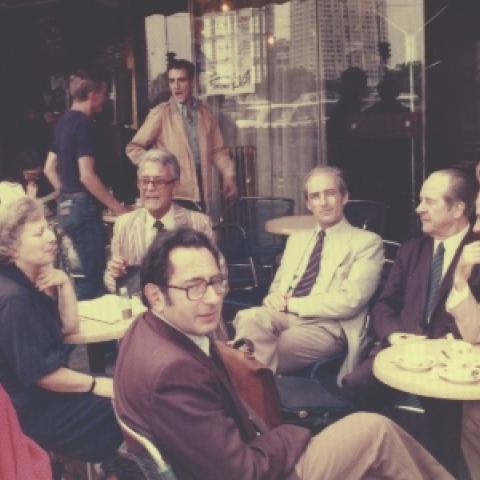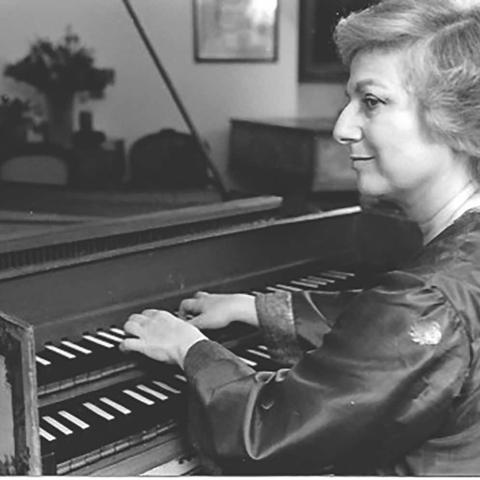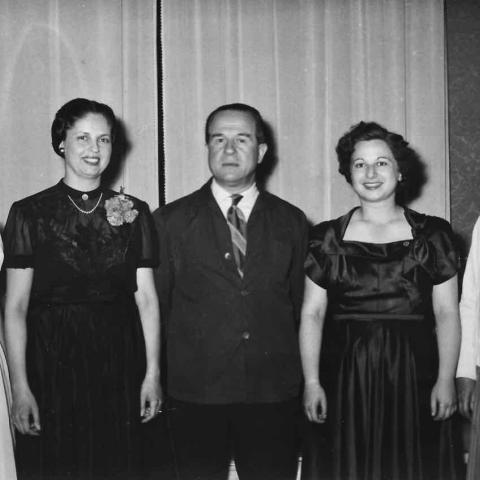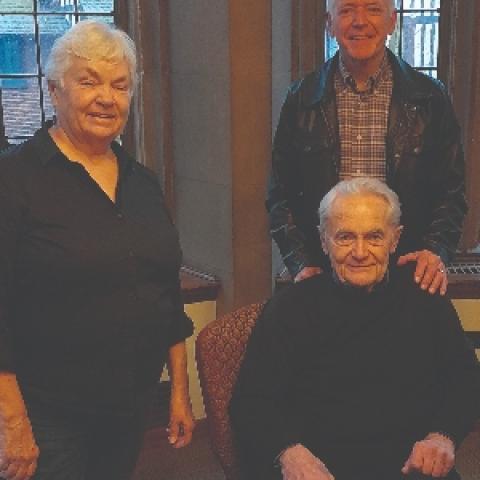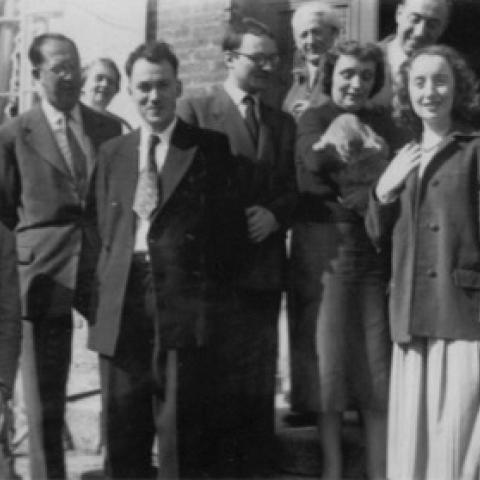Born in New York City, Sally Gordon-Mark has French and American citizenships, lives in Europe, and is an independent writer, researcher, and translator. She is also a musician—her professional life began in Hollywood as the soprano of a teenage girl group, The Murmaids, whose hit record, Popsicles & Icicles, is still played on air and sold on CDs. Eventually she worked for Warner Bros. Records, Francis Coppola, and finally Lucasfilm Ltd., in charge of public relations and promotions, before a life-changing move to Paris in 1987. There Sally played harpsichord for the first time, thanks to American concert artist Jory Vinikour, her friend and first teacher. He recommended she study with Huguette Dreyfus, which she had the good fortune to do during the last three years before Huguette retired from the superieur regional conservatory of Rueil-Malmaison, remaining a devoted friend until Huguette passed away.
During Sally’s residence in France, she organized a dozen Baroque concerts for the historical city of Saint-Germain-en-Laye, worked as a researcher for books published by several authors and Yale University, and being trilingual, served as a translator of early music CD booklets for musicians and Warner Classic Records. She also taught piano privately and at the British School of Paris on a regular basis. In September 2020 she settled in Perugia, Italy. In March 2023 Sally was the guest editor of the British Harpsichord Society’s e-magazine Sounding Board, No. 19, devoted entirely to the memory of Huguette Dreyfus. For more information: www.sallygordonmark.com.
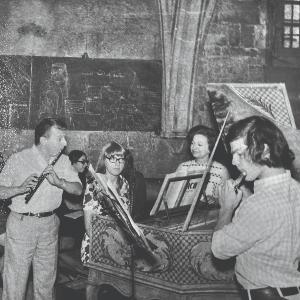
Editor’s note: Part 1 of this series appeared in the March 2023 issue of The Diapason, pages 18–20; part 2 appeared in the April 2023 issue, pages 14–19.
“I was very attached to her, as one is to teachers who allow you to make huge strides in little time.” —Judith Andreyev2
By the 1980s, it had become customary for harpsichordists and organists from all over the world to come to France or the Netherlands to study and perfect their technique with Huguette Dreyfus, Kenneth Gilbert, and Gustav Leonhardt. Huguette’s concert tours and recordings had brought her international renown. She had a great gift for teaching, and with foreign students she could speak English, German, and Italian fluently. “Huguette has an absolutely fabulous sense of teaching, and she can communicate what she knows with enthusiasm.”3 Many of her students who had succeeded professionally continued to play for her before concerts, recordings, and tours. But Huguette would say in an interview late in life that her students did not need her as much as she needed them.4 Her students who became concert artists include harpsichordists Olivier Baumont, Emer Buckley, Jocelyne Cuiller, Maria de Lourdes Cutolo, Gaby Delfiner, Yves-Marie Deshays, Matthew Dirst, Elisabeth Joyé, Yannick LeGaillard, Laure Morabito, Pamela Nash, Kristian Nyquist, Mariko Oikawa, Joël Pontet, Christophe Rousset, Heather Slade-Lipkin, Noëlle Spieth, Ann Cecilia Tavares, Yasuko Uyama-Bouvard, Blandine Verlet, Jory Vinikour, Ilton Wjuniski, as well as organists Philippe Bardon, Véronique LeGuen, Frank Mento, and David Noël-Hudson.
Huguette began teaching when she was only fourteen years old, during her family’s stay in Switzerland with relatives after they had fled France over the Alps in December 1942. This was after she had received a first prize in her piano exam at a superior level from the Conservatory of Clermont-Ferrand. When she entered the Conservatory of Lausanne, she enrolled at the virtuoso level and was allowed to pass her final exams in Clermont-Ferrand when the war ended, winning another first prize. After settling in Paris in 1945, she taught privately while she pursued her own studies at the Paris Conservatory, the Ecole Normale de Musique (she also received top prizes at the two schools),5 and in Ruggero Gerlin’s two-month summer harpsichord course at the Accademia Chigiana in Siena. Teaching would remain very important to her all her life, even when she became one of the most important French harpsichordist of her generation.
It is not commonly known that her earliest protégé was Blandine Verlet, whose individual and distinctive way of playing would have found sustenance in Huguette’s tendency to encourage her students to think for themselves and find their own interpretative styles. Blandine took private lessons with her regularly beginning in 1958, when she was enrolled in Marcelle Delacour’s class at the Paris Conservatory, until as late as 1969 (although less frequently once her own career took off).6 It is clear from Huguette’s agendas and documents that she gave her particular attention. On September 16, 1962, Blandine’s father, the distinguished Dr. Pierre Verlet, chief conservator of the Louvre Museum and renowned art historian, wrote:
Please allow me to express our gratitude to you for all you have done for Blandine. You were a mother to her in Siena, from which she returned this morning, delighted.7
In 1963 Blandine was awarded a unanimous first prize from the judges as well as a special prize at the International Competition of Munich. Huguette not only coached her for the competition, but would promote her career in general by introducing her to her own mentors, Alexis Roland-Manuel and Norbert Dufourcq, inviting her to programs on which she was featured, proposing she study with Gerlin in Siena, and inviting her to play on a recording of the Bach concerti in 1965.8 In 1969 Dr. Verlet would write regarding a radio program on which Blandine had appeared with Huguette, after having returned from studying with Ralph Kirkpatrick at Yale University:
How to thank you too for the place that you gave to Blandine in the [radio] program. A little secret: in a quick word, two days after her arrival home she said: “I’ve already taken the piece to heart again. . . . Mademoiselle Dreyfus has magnificently made me work. . . .” Again all my admiration and my gratitude.9
In later years, the two women would become estranged, and as a result, Huguette’s teaching and nurturing of Blandine have been overlooked.
From July 1 through August 9, 1966, Huguette gave harpsichord lessons along with Pauline Aubert and Marguerite Roesgen-Champion during an early music event, “Summer in France,” sponsored by the Paris American Academy of Music in Fontainebleau, at the invitation of Nadia Boulanger, its director.10 In 1967 she was named professor of harpsichord at the Schola Cantorum in Paris, a position that she kept until 1990. Her students included a young Christophe Rousset, who ended up taking his lessons in her home on Saturdays, because his school schedule did not permit them during the week.11
From 1971 until 1982, Huguette taught basso continuo at the Sorbonne where Olivier Papillon was in her class.12 When she left there, she asked harpsichordist Richard Siegel to take her place.13 During that period Huguette was also the harpsichord professor of what was then a municipal conservatory in Bobigny, just north of Paris. Students in that class included Maria de Lourdes Cutolo and Ilton Wjuniski, who were scholarship recipients from Brazil, Elisabeth Joyé, Joël Pontet, Gaby Delfiner, Renaud Digonnet, and Yannick LeGaillard. In 1982 she was named harpsichord professor at two major conservatories in France: what were then called the Conservatoire national supérieur de musique in Lyon and the Conservatoire supérieur de région in Rueil-Malmaison. A harpsichord class was created at the latter specifically for her, and also an organ class for Marie-Claire Alain.14 When it came time to retire, Huguette left the Lyon conservatory in June 1993 (Françoise Lengellé took her place) and then a year later the Rueil-Malmaison conservatory, where Olivier Baumont, a former student and now the professor of harpsichord at the Conservatoire national supérieur de musique et de danse de Paris, replaced her.
In addition to her regular teaching positions, Huguette gave annual summer workshops in the Provence region of France, first in Saint-Maximin-La-Baume and then in Villecroze. Claude Mercier-Ythier described how it came about:
An event happened that would be very important for us: the creation of early music classes at Saint-Maximin’s former monastery . . . where there is an extraordinary organ. The young man who should have taught there was Louis Saguer. [However, shortly before he was supposed to start teaching,] he had been invited to give an important series of concerts in Argentina. The organizer, Dr. Pierre Rochas . . . looked desperately for a replacement. So I took him to see Huguette Dreyfus who immediately took on the classes, without knowing that we would spend [15 summers there]. Huguette was a pedagogue without equal, with an international reputation.15
In 1964, five lecture recitals were held by Huguette. They were so successful that a year later, harpsichord classes were organized.16 Claude Mercier-Ythier provided the instruments. Her frequent collaborator at the time, Christian Lardé, joined her. He taught flute, and together they gave classes in ensemble playing. The classes were given under the auspices of the French Organ Academy for the Interpretation of 17th and 18th century music (l’Académie de l’orgue français pour l’interprétation de la musique des XVIIème et XVIIIème siècles), which was created not only by Dr. Pierre Rochas, but by a Dominican priest, Father Henri Jarrié, as part of their efforts to save the convent from destruction and restore the famous organ in the basilica.
Father Jarrié’s contribution to the early music revival in France seems to be unknown; his story is worth telling. Born in 1924, he began his theology studies in the Saint-Maximin monastery. A musician, he had taken piano lessons from the age of six and also composed music. Among the many artists and intellectuals who visited Saint-Maximin was André Coeuroy, a musicologist and critic, who took a look at his compositions and encouraged him. Then at the music festival in Aix-en-Provence, he met Louis Saguer, also a composer, and arranged to study musical analysis and composition with him. In 1952 he received the unusual post of “Chaplain to the Artists” in Nice, coming into contact with Cocteau, Picasso, and Matisse, among others. Then in 1961, Père Jarrié was named parish priest of the village of Saint-Maximin.
The Dominican order was preparing to sell the monastery there, which they had already left. Father Jarrié and others formed a group to safeguard it, and by the end of the 1960s it had become a cultural center. Father Jarrié inaugurated a series of concerts in the cloisters that became the first festival to focus on early music; at the time, the only music festival that existed in France was in Aix-en-Provence. The Dominican priest and Dr. Pierre Rochas were also responsible for the restoration of the Basilica of Saint Marie-Madeleine’s historic eighteenth-century organ built by Frère Isnard and the creation of the Academy, which together with the concert series would be important not only for Huguette’s career, but also for the international dissemination of early music. For fifteen years, Huguette went there every summer to teach and concertize. Eventually Eduard Melkus joined her and Christian to teach violin. In 1971 Jarrié left the priesthood to consecrate his life to music and teaching:
There were so many students who frequented my courses during 15 years. They came from all over the world and then spread the knowledge that they had acquired in their own respective countries.17
There were many lighthearted moments that eased the intensity of the lessons. Among Huguette’s archived documents is a Certificat St Maximin: “The Jury certifies that Mlle Huguette Dreyfus and Christian Lardé took the Viennese Waltz class in the performance course at the 15th Summer Academy of St-Maximin. Ed. Melkus.”18 A participant, harpsichordist Maria de Lourdes Cutolo, remembers playing Brazilian music for Huguette, which she loved, while Eduard improvised on the violin.19
Maria de Lourdes Cutolo and Ilton Wjuniski were two young Brazilian harpsichordists whom Huguette had met in São Paôlo, then the capital of Brazil, on the occasion of the “Course-Festival of Harpsichord Interpretation” held in São Paôlo’s major art museum (MASP) from October to December 1975. The courses were taught by Helena Jank, Maria Helena Silveira, and Felipe Silvestre. New works for solo harpsichord were commissioned from composers Souza Lima, Osvaldo Lacerda, and Almeida Prado. Huguette was invited to give classes and recitals from October 3 through 26. During her stay, she flew to Rio to meet Roberto de Regina, an important harpsichordist, teacher, and the first to build a harpsichord in Brazil.20 He also created the first early music group there.21
Huguette’s teaching influenced several pupils profoundly. “Stimulated by this contact, some young artists pursued training with the harpsichordist in France, such as Ilton Wjuniski, Maria Lucia Nogueira, and Maria de Lourdes Cutolo.”22 They were awarded scholarships by the festival sponsor, the Secretary of Culture, Science, and Technology, to come to France.23 A decade later, Ana Cecilia Tavares, another Brazilian artist, would also go to study with Huguette at the Rueil-Malmaison conservatory near Paris.24 Harpsichordist, teacher, and author Marcelo Fagerlande credits Huguette with the surge in interest for the harpsichord in Brazil after her stay there.
Maria Lourdes de Cutolo wrote to Huguette several times in early 1976 to solicit her help in finding lodgings in Paris and a spinet to use. Huguette sent her information on spinets, but in the end, moved her own spinet into a spare bedroom, where Maria could practice every day if she liked.25 Huguette often helped students with practical concerns as well as with personal problems, at the same time guarding a professional distance. She maintained the reserve between people of different positions, or those who do not know each other well, that prevails in European culture: the maestro or maestra is treated with respect, and familiarity would be inappropriate. Her students were invited to address her by her first name, but never would have thought to address her by the familiar “tu.”
Another country important to Huguette was Japan, where she made lifelong friendships. She met a Japanese student, Miwako Shiraï, at Saint-Maximin where the flautist was studying with Christian Lardé. When Huguette was invited in 1979 by Mariko Oikawa, a former student in France, to play concerts in Japan and record an album with the group, Tokyo Solisten, of which Mariko was the harpsichordist, she called upon Miwako to accompany her and act as translator. In Japan, Huguette was welcomed by the father of another of her students, Yasuko Uyama-Bouvard, who had come to France in 1976. Her father, wanting to introduce the ever-curious Huguette to Japanese culture, invited her to an “exceptional restaurant where there is Shiki-botyo, the knife ceremony, which was performed in the past by the cook to the Japanese court. The cook prepares fish without touching it with his hands.”
Huguette returned to Japan in 1981. During Huguette’s free time, Mariko and her husband Shigeru, with their daughter Reine, about three, took her on visits. Yasuko came from France to stay for a week at the urging of her father who, grateful that Yasuko had won first prize at the Festival Estival international harpsichord competition in Paris in 1979, wanted to honor Huguette. He presented her with a stay at a traditional Japanese hotel. Yasuko went with Huguette and Mariko to Nara Park (Shigeru had to take Reine back to Tokyo), where thousands of deer run free and it is possible to feed and pet them.26
In 1983 Huguette spent nearly a month in Japan from October 8 through November 4, recording for Denon and performing in Tokyo, Nagoya, and Kyoto. In her free time, she went sightseeing often with the Oikawa family:
The trip that left the biggest impression was our voyage to Kyoto. We visited Nara Park the day before her concert in Kyoto. She found herself surrounded by deer and she said that she was astonished that the most easily frightened animals in the world would eat out of the palm of a man’s hand. She spent a good amount of time playing with them. We also went by car to Hakone. Descending Mount Hakone, we encountered the historic Daimyô procession. We watched it and then walking in the city of Odawara, we visited the chrysanthemum festival.27
Huguette would return to Japan in the future, but sadly, Mariko would not be there to welcome her. Only thirty-nine-years old, she passed away from cancer on July 25, 1988, leaving behind two children, Reine, and a boy, Kentaro, born in 1984. Fifteen years later, Reine would become a harpsichordist herself and come to France intermittently to study with Huguette at Villecroze and in her home on Quai d’Orsay in Paris.
In 1979 Huguette left the Academy in Saint-Maximin. In 1983 she joined the Académie de Musique Ancienne in Villecroze to give summer masterclasses, which she did until 2008. Claude Mercier-Ythier, who had loaned his historic 1754 Henri Hemsch, Huguette’s favorite instrument, for the Saint-Maximin sessions, continued to supply it and other harpsichords for the classes at Villecroze. At both academies, friends, including Melkus, Lardé, and his wife, harpist Marie-Claire Jamet, joined her to concertize and give instrumental and chamber music classes. In Villecroze classes were held in the morning, and afternoons were free, when students practiced and swam in the pool. Sunday was a day off, and there were group outings organized for them, such as boat rides and sightseeing. It was “paradise on earth,” according to one of the students, Kristian Nyquist.28
In addition to masterclasses in France during the summer, Huguette was invited regularly to give them all over the world. She also sat on juries for harpsichord exams at conservatories and for harpsichord festivals. For at least twenty-five years, there was a biennial international harpsichord festival in October in Paris, the Festival Estival. Huguette was often on the jury, and in February 1990 she was invited to write a page for the brochure celebrating the twenty-fifth anniversary of its creation on March 7 that year.29 Often she sat on juries with friends, former students, and other distinguished colleagues, such as Colin Tilney, Zuzana Ružicková, Rafael Puyana, Gustav Leonhardt, Scott Ross, Kenneth Gilbert, and Luciano Sgrizzi.
Three radio programs in 197930 featured her and some of her students at the Bobigny Conservatory: Maria de Lourdes Cutolo, Christophe Rousset, and Ilton Wjuniski. When asked what she told students who express a desire to pursue a career, she called it a very big responsibility and said she tended to discourage the idea. By discouraging them, she meant that she did not want to “throw rose powder in their eyes and mislead” anyone. She would tell a student, “A career is very difficult even if you are very talented and are supported by your family. Your field has to be well learned, which takes a lot of time. It takes time to launch a career, and it requires a lot of courage.” Huguette herself had suffered big obstacles to her own career and had worked very hard and made sacrifices. But she knew that if the student was possessed “by the demon of music, by the demon of the stage, by the demon of a career,” nothing she said could change his or her mind. “The true, the pure artist will remain.” She recognized that the mere fact of playing before one’s peers in a classroom was already very intimidating, and she took her role very seriously. “The tighter the relationship between student and teacher is, the more the teacher has to pay attention.”31
When possible, Huguette gave her students the chance to perform publicly on radio programs where she herself was featured, and a few played on recordings of hers. Among her documents is a letter from a well-known French harpsichordist who was her student in the 1970s, “I know what I owe you, . . . you are the person who counts most in my harpsichord vocation.”32 Her kindness and generosity is still remembered today. She often gave students rides to the summer workshops in Saint-Maximin and Villecroze, which could not be reached directly by train. One of her American students, Ellen Haskil Maserati, remembers their trip to Siena to take Gerlin’s class, “She was really nice when we drove down. We stopped overnight in Lyon. She took me to dinner and had me try all the local food. She was very motherly.”33
Her genius for teaching resided in her wanting to respond personally to her students, feeling that a teacher should always understand the personality of the student and determine what possibilities there were to develop. During the lessons she was demanding, but she did not ask for obedience. Her intention was not to impose her ideas; she preferred that the student have his or her own. In this approach, it is possible to see the influence of her teachers at the Paris Conservatory. One teacher, Norbert Dufourcq, when grading an essay she had written on the “different manifestations of choral music in the vocal works of Bach,” noted, “You have read many texts . . . to the point where [your essay ends up sounding] a bit like a catalog sometimes. What is lacking is a personal judgment, a thought that is yours and the fruit of your reflections as a good musician.” Also, Huguette’s pedagogy teacher, a Mr. Norpain, had given advice that she clearly had taken to heart, “Before speaking, listen to the student with so much attention that you immediately get a clear idea of his strengths and weaknesses.”34
During a radio broadcast from Ville-croze on November 9, 2000,35 Huguette said in the course of a masterclass:
As far as I’m concerned, you arrive at technique through the music and not the other way around. . . . When you have something you want to express but you don’t have the technical means to express it, it’s up to you to find exercises that will permit acquiring those means. . . . To learn a sensitive touch, the finger has to feel the plectrum scratch the string. [She felt that “plucking the string” was not an accurate term.] There is an important relationship between the sensitivity of the fingers and the ear, and that’s what you must work on. The ear must hear differences. . . that makes part of the everyday work when you’re doing finger exercises. In fact, it’s musical, and I personally feel that no exercise should ever be done mechanically. You must always be in conversation with the music. Even if you do so-called daily exercises, you can always find these passages in pieces. You have to consider them musically. I always use as a reference the human voice or a wind instrument for understanding how to let the music breathe.36
Huguette was famous with her students for her frequently repeated “proverbes dreyfusiens.” One student, Chiao Pin Kuo, remembered some of these aphorisms in a tribute to her after her death:
The notes are not the music, the music lies between them.
When you play a piece, the listener has to understand everything as if he has the music in front of his eyes.
Without respiration, the music is dead.
To breathe is not to slow down, slowing down is not breathing.
It’s not enough to know how to play, you have to have a wide knowledge of not only harpsichord music but of all forms of art. If you are small-minded, you won’t ever be a great musician.
Practice, listen, converse, and feel the composer speaking.37
Up until now, I have spoken in the third person. But now, as one of Huguette’s former students and friends, I will speak in the first person. It has been nearly a quarter of a century since I studied with her during her last three years at the Conservatoire de Rueil-Malmaison. But she made such an impact on me that I still recall most of her teachings. I had never had the opportunity to study with someone of her caliber before and must have realized that every bit of the experience was precious and needed to be carefully stored away in my memory. I was a middle-aged amateur pianist, and the first chance I ever had even to touch a harpsichord came the year before when I started taking lessons from the American harpsichordist, Jory Vinikour. He was in Paris on a Fulbright scholarship to perfect his prior training with Huguette and Kenneth Gilbert. It was Jory who encouraged me to audition for Huguette to enter her class at the conservatory. Despite trembling hands, I played for her and was accepted.
In our class at Rueil-Malmaison, we always celebrated birthdays, especially hers. One year, we threw a surprise party for her in the apartment of her cousin, Nicole Dreyfus (a famous attorney in France). Four students played variations of “Happy Birthday,” squeezed together at Nicole’s piano, I and another improvised a tango, and four held up one of her aphorisms, written out on pieces of paper. Huguette would have all her students over to dinner after the year-end exams, serving chocolate cake she had baked herself. At the conservatory, it was forbidden to eat in the teaching room, but Huguette installed a coffee maker, and we often ate our lunches there and celebrated birthdays and holidays with cake and champagne.
What Huguette taught me did not only concern the keyboard and written notes—it had to do with how to practice, making the instrument sing, acquiring the confidence to play difficult pieces, performing. . . . She said I could go as far as I wanted to in my playing, and I ended up being able to play pieces that I never would have been able to before. Her observations were always accurate, and her comments always constructive; Huguette could also say much with just an evocative gesture. All of this advice enabled me to play in public and be awarded a unanimous first prize in a jury exam, which would have been impossible before I studied with her:
Listen to the bass.
To feel the beat and speed of a piece, walk ‘round the room, singing the melody.
To perform a piece, it needs to be more than 100% ready.
Be aware of the environment in which you’re practicing at home. When you’re learning a piece, the brain is storing it, not as isolated bits of information, but in its whole context, which will be reproduced when you perform.
Have everything prepared for performance, including the music so there are no loose pages to get lost or fall on the floor.
Listen to what you play all the way to the end.
When one hand is playing a tricky passage, listen to the other one. (This was particularly effective when I was learning how to play ornaments.)
All that counts is the music.
Learning a fugue, sing each part separately. As you play one voice, add a second one with the other hand. Practice playing one voice while you sing with the other. While you play all the voices, follow each one individually.
Playing each part hands together strengthens how it’s learned in the brain.
Don’t think about the notes. Imagine the trouble a centipede would have walking if it thought about how it moved!
Huguette rarely noted anything on my music, except to circle rests and add fingering—but only occasionally. More often, she would come by and tap on my shoulders, which had risen up to my ears with tension (terror, because of playing in front of the class, might be the more accurate word!). This recurring at every lesson, she showed me some exercises to relax them. She did not insist about fingering, saying that it was an individual decision, given that hands are different. Giving Glenn Gould as an example, Huguette pointed out that artists could sit or hold their arms in the “wrong ways” and still be brilliant.
Her own musicality was extraordinary. Once when I was playing in class, a woman from the conservatory office came to the door. Huguette told me to keep playing and went to speak to her. Suddenly she interrupted herself to call out to me, “B-flat!” I had made a mistake, and she heard it despite their conversation.
Referring to her practice of going to see something beautiful at a museum before giving a concert, she said in an interview with an Italian reporter, “It’s like giving water to a flower for it to bloom easily.”38 To me, this quote could be a metaphor for her teaching. Once, when I was visiting her in the hospital before her death—some of her other students and I were in touch so as to maintain a continuous flow of visits—a nurse asked me if we were Huguette’s family members. “No,” I responded, “we’re the flowers in her garden,” knowing I’d puzzle her, but not finding any other apt way to put it in my distress. Now that I have gathered testimonials for a commemorative issue, I see that others felt as inspired and nurtured by her as I did, such as Yasuko Uyama-Bouvard who wrote, “She transmitted her love of music to me.”39 Huguette could draw the best out of a student, and in my case, it changed the way I thought about myself and my capacities. Her next step was to help give me the capabilities to play the music I chose. Huguette took me as seriously as she would have if I had been young and a prospective professional. As another adult amateur student said, “Gratitude is the greatest homage that one can pay her.”40
To be continued.
Notes
1. “The budding lilies,” title of the first piece by François Couperin in his 13ème Ordre, Troisième Livre.
2. Email to author, December 7, 2016.
3. Radio interview, “Denis Herlin,” Les traversés du temps, France Musique, March 21, 2012.
4. Radio interview by Marcel Quillévère, “Huguette Dreyfus claveciniste,” Les traversés du temps, France Musique, March 7, 2012.
5. BnF VM FONDS 145 DRE-3 (12).
6. Agendes, BnF VM FONDS DRE-3 (5).
7. Letter from Pierre Verlet to Huguette Dreyfus, September 16, 1962, BnF VM Fonds 145-DRE (23).
8. LP, The complete concerti for harpsichord, J. S. Bach, “A Critère recording,” Paris. Musidisc, France. New York: Nonesuch, HE 73001, 1965. Complete discography of Huguette Dreyfus compiled by the author. dolmetsch.com/huguettedreyfusdiscography.htm.
9. Letter from Pierre Verlet to Huguette Dreyfus, July 15, 1969, op. cit.
10. Brochure, Paris American Academy of Music, “Summer in France,” 1966. BnF VM FONDS 145 DRE-3 (12).
11. Christophe Rousset, in emails to the author between 2016 and 2023.
12. Olivier Papillon, phone interviews with author, December 16, 2016, April 6 and
10, 2017.
13. Richard Siegel, interview with author, November 17, 2016, Paris, France.
14. Susan Lansdale, interview with author, March 23, 2018, Le Pecq, France.
15. Claude Mercier-Ythier, in tribute to Huguette Dreyfus, Clavecins en France (CLEF) clavecin-en-france.org/spip.php?article288. Translated from French by the author.
16. Huguette Dreyfus, radio interview, Les traversés du temps, op. cit.
17. “Toujours jeune, L’Académie d’été, 40 ans déja.” Orgues Nouvelles, No. 15, Summer 2008, Lyon.
18. BnF, VM FONDS 145 DRE-3 (12).
19. Maria de Lourdes Cutolo, email to author, March 20, 2022.
20. Marcelo Fagerlande, phone interview with author, October 21, 2022.
21. bach-cantatas.com/Bio/Regina-Roberto.htm.
22. Marcelo Fagerlande, Mayra Pereira, and Maria Aida Barroso, O Cravo no Rio de Janeiro do século XX. Rio de Janeiro: Rio Books, 2020.
23. Ilton Wjuniski, tribute to Huguette Dreyfus, 2013.
24. Ana Cecilia Tavares, tribute to Huguette Dreyfus, 2022.
25. Letters from Maria de Lourdes Cutolo to Huguette Dreyfus, January 14 and February 2, 1976 BNF VM FONDS 145 DRE-1 (17).
26. Yasuko Uyama-Bouvard, emails to author, January 2023.
27. Shigeru Oikawa, letter to author, September 25, 2017, and tribute, January 2023.
28. Kristian Nyquist, interview on April 27, 2017, and later phone calls and emails.
29. BnF, VM FONDS 145 DRE-3 (12).
30. ‘Musiciens pour demain,” François Serrette, France Musique, February 15 and 22, 1979.
31. “Musiciens pour demain,” op.cit., radiofrance.fr/francemusique/podcasts/les-tresors-de-france-musique/musiciens-pour-demain-avec-huguette-dreyfus-et-christophe-rousset-une-archive-de-1979-4597434.
32. Letter from Noëlle Spieth to Huguette Dreyfus, BnF VM Fonds 145 DRE-1 (17).
33. Ellen Haskil Maserati, interview with author, June 2018, Paris.
34. BnF VM FONDS DRE-3 (1).
35. Villecroze: l’atelier de clavecin de Huguette Dreyfus, Les chemins de la musique, France Culture, Radio France, broadcast November 9, 2000.
36. Huguette Dreyfus, radio interview, L’Académie musicale de Villecroze, November 22, 2000.
37. Translated from French by the author. clavecin-en-france.org/spip.php?article288.
38. Huguette Dreyfus interview, Corriere dell’Umbria, February 18, 1999. Translated from Italian to English by the author.
39. Email to author, January 5, 2023.
40. Pascal da Silva Texeira, email to author, December 2016.

